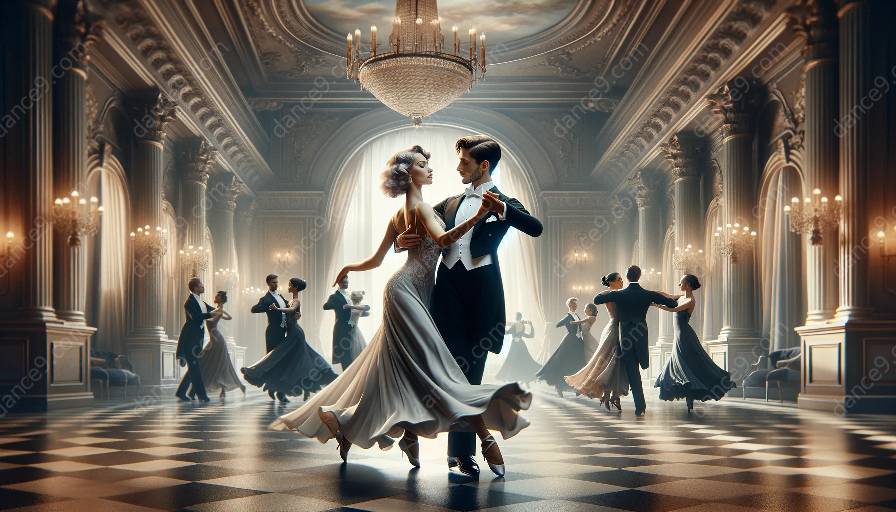The Waltz is a classic dance style that embodies grace, elegance, and romance. It is a significant part of dance classes and performing arts (dance), captivating audiences with its beauty and sophistication.
History of the Waltz
The Waltz originated in the late 18th century in Vienna, Austria. It was considered scandalous at the time due to its close hold and rotation, breaking the traditional dance protocols. However, it gained popularity and gradually evolved into different styles over the years.
The Waltz has played a vital role in the history of dance, influencing other dance forms and contributing to the development of ballroom dance as we know it today.
Techniques and Movements
One of the defining features of the Waltz is its smooth and flowing movements. Dancers move in a graceful, continuous motion, gliding across the dance floor with poise and sophistication.
Key techniques include proper posture, frame, footwork, and precise timing. The Waltz requires a strong connection between dance partners, as they move as one in harmony and grace.
Significance in Dance Classes
The Waltz is a fundamental dance style taught in many dance classes, offering students the chance to learn and master its elegant movements. It provides a solid foundation for understanding rhythm, musicality, and partnering skills.
Learning the Waltz enhances coordination, balance, and overall body awareness, making it an essential part of dance education for students of all ages.
Role in Performing Arts (Dance)
Within the realm of performing arts, the Waltz is often featured in theatrical productions, dance showcases, and ballet performances. Its timeless appeal and emotional expressiveness make it a popular choice for choreographers and performers.
Whether as a solo performance or a group ensemble, the Waltz captivates audiences with its beauty, grace, and storytelling potential.
Conclusion
The Waltz remains a beloved and essential part of dance classes and performing arts (dance), showcasing the enduring appeal of its graceful movements and emotional depth. Its rich history, technical intricacies, and timeless elegance continue to inspire dance enthusiasts and performers worldwide.
Topic
Cultural significance of the waltz in dance history
View details
Physical and mental benefits of learning the waltz
View details
Waltz as a form of self-expression and storytelling
View details
Role of waltz in social and ballroom dance settings
View details
Waltz as a tool for enhancing interpersonal communication
View details
Understanding the rhythmic structure of waltz music
View details
Comparative analysis of waltz and other ballroom dances
View details
Psychological aspects of waltz performance and appreciation
View details
Social and cultural implications of waltz in different societies
View details
Adapting waltz for contemporary dance and artistic expression
View details
Incorporating waltz into dance therapy and wellness programs
View details
Waltz as a vehicle for exploring gender roles in dance
View details
Creative choreography and improvisation in waltz performance
View details
Collaborative and partnership dynamics in waltz routines
View details
Integrating waltz into multidisciplinary arts and performances
View details
Global influences on the evolution of the waltz
View details
Teaching methods and pedagogical approaches for waltz instruction
View details
Integrating technology and innovation in waltz education
View details
Waltz as a reflection of societal values and norms
View details
The future of waltz as a contemporary dance form
View details
Questions
How can waltz improve balance and coordination?
View details
What historical context shaped the development of the waltz?
View details
How does waltz contribute to overall physical fitness?
View details
What cultural influences have impacted the waltz?
View details
How can waltz enhance social skills and interactions?
View details
What are the techniques for mastering waltz turns?
View details
How does waltz promote teamwork and partnership?
View details
What role does waltz play in traditional ballroom dancing?
View details
What are the health benefits of waltz for individuals of all ages?
View details
How does waltz build confidence and self-expression?
View details
What makes the waltz a timeless and enduring dance form?
View details
What are the cultural variations of the waltz in different regions?
View details
How can waltz be used to communicate emotions and stories?
View details
What are the historical figures that contributed to the evolution of the waltz?
View details
What are the musical elements that define waltz compositions?
View details
How does waltz connect to other dance forms and styles?
View details
What are the etiquette and traditions associated with waltz?
View details
How does waltz encourage creativity and improvisation?
View details
What are the psychological benefits of learning and performing the waltz?
View details
How does waltz foster a sense of community and belonging?
View details
What role does waltz play in contemporary dance culture?
View details
How can waltz be adapted for modern interpretations and performances?
View details













































































